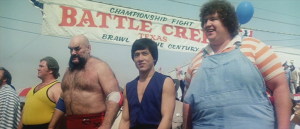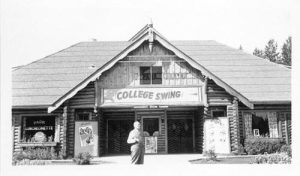Battle Creek Brawl / The Big Brawl (1980) by #RobertClouse
w/ #JackieChan #JoséFerrer #KristineDeBell #Mako
A young martial artist is forced to participate in a brutal street-fighting competition.#Crime #Action #Comedy#NotQuiteClassicCinema pic.twitter.com/xFJsWW1ZOw
— Angus Kohm (@AngusKohm) September 19, 2020
 I remember renting The Big Brawl (1980) in a giant clamshell case back in my earliest days of home video viewing.
I remember renting The Big Brawl (1980) in a giant clamshell case back in my earliest days of home video viewing.
Okay, I didn’t actually rent the big clamshell case. I looked at it in the store, and then took it up to the front, where they exchanged it for a plain plastic case (either black or transparent depending on which store I was in) with the Beta tape inside of it. At least one of the stores I frequented used a tag system. Instead of bringing the box up to the front, you brought up a small tag which was attached to the box with velcro. If the tag wasn’t there, you knew the movie was rented.
I don’t think I’d ever heard of Jackie Chan at that point. I had heard of Bruce Lee, who was a bit of an icon, but I don’t think I’d seen any of his movies. I had probably already seen Jackie Chan in The Cannonball Run (1981), which my whole family had gone to see in The Park Theatre, “the largest log cabin theatre in North America”, while on summer vacation. Jackie played one of the drivers of the Subaru in that movie. I certainly remember him in that, but I don’t think I had any idea who he was at the time.
I loved The Big Brawl when I first watched it, and I’m pretty sure I immediately watched it a second time (which I often did with movies I rented in those early days). I may have even squeezed in a third viewing before having to return the tape by 5:00 PM the next day. To me, the movie was non-stop action, with a bit of comedy, and I don’t think I’d ever seen anything quite like it. I used to watch AWA Wrestling on Saturdays, and in some ways, The Big Brawl evokes a bit of that atmosphere, as our hero has to face off against very large guys who look just like professional wrestlers (and in fact were, in some cases).
 I couldn’t help but laugh, as Jackie Chan looked so tiny standing next to the other contestants in The Battle Creek Brawl. He may have been smaller, but as we were about to learn, he could fight like nobody else.
I couldn’t help but laugh, as Jackie Chan looked so tiny standing next to the other contestants in The Battle Creek Brawl. He may have been smaller, but as we were about to learn, he could fight like nobody else.
Jackie Chan, aside from being a really good fighter, was just so darn likeable. He was sympathetic, and seemed like an ordinary guy with problems with which other ordinary people could identify (such as a strict father who didn’t want Jackie to follow his passion; studying martial arts with his uncle). Jackie wasn’t a super-macho hero who always looked cool. He was funny, and he wasn’t afraid to look extremely “uncool” is some instances. Again, anyone who had ever felt awkward or embarrassed could identify.
I was surprised that I didn’t see more of Jackie Chan over the next few years. But I don’t think my Mom and Pop video stores had a huge selection of Hong Kong movies, and unfortunately, The Big Brawl had not been a rollicking success and Jackie did not appear in a lot of other mainstream Hollywood films at that time.
Fast forward to the 1990s, and I (along with the rest of North America) rediscovered Jackie Chan when movies like Rumble In The Bronx (1995) came out. The mainstream audience was finally ready for Jackie, and couldn’t have been happier. I explored many of his older films, like Drunken Master (1978) and I was amazed at how great they were.
Watching The BIg Brawl for the first time in more than thirty years, it was obvious how restrained it was for a Jackie Chan movie. It is certainly not in the same category as films like Drunken Master and Snake in the Eagle’s Shadow (1978). My understanding is that they were trying to make Jackie Chan more accessible for the North American audience. They believed that western audiences would not be able to handle the pure, unadulterated Jackie Chan. It’s hard to say if they were right or wrong, but The Big Brawl failed to find mainstream success in North America. Was it because audiences weren’t ready for Jackie (even in a watered down form)? Or was it because they had tampered with Jackie (and watered him down)? I suppose we’ll never know.
However, I found The Big Brawl to be a delightful, nostalgic return to my childhood. It contains some great moments, and Jackie is as charming as ever. Of course it can’t compete with some of the better Hong Kong movies, but that’s okay. It is what it is, and I like it. I was surprised by how well I remembered the music by Lalo Schifrin, which I found extremely catchy. The movie was directed by Robert Clouse, who is perhaps most famous for Enter the Dragon (1973) and maybe Black Belt Jones (1974) – both movies I like a lot. Enter the Dragon is the best of the bunch, and far superior to The Big Brawl in a lot of ways. But I have more of a personal relationship with The Big Brawl. It was the first movie of it’s kind that I ever saw, and as such, will always be very special to me.
Battle Creek Brawl / The Big Brawl (1980) is a fine example of #NotQuiteClassicCinema. There are better Jackie Chan movies, but none that I saw on a #FridayNightAtTheHomeDriveIn when I was young.

